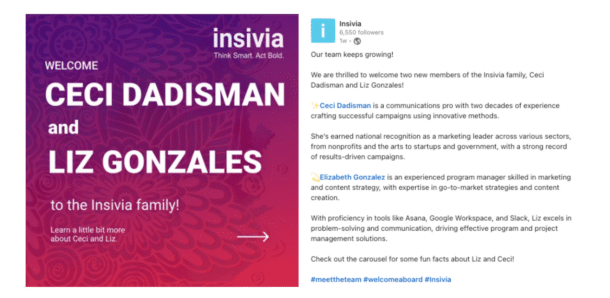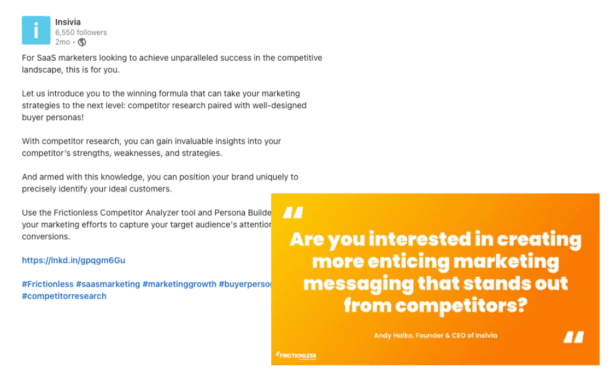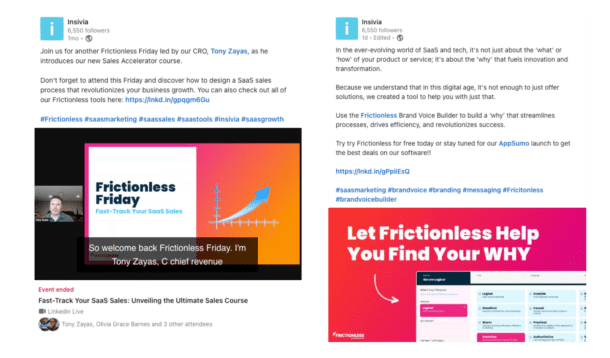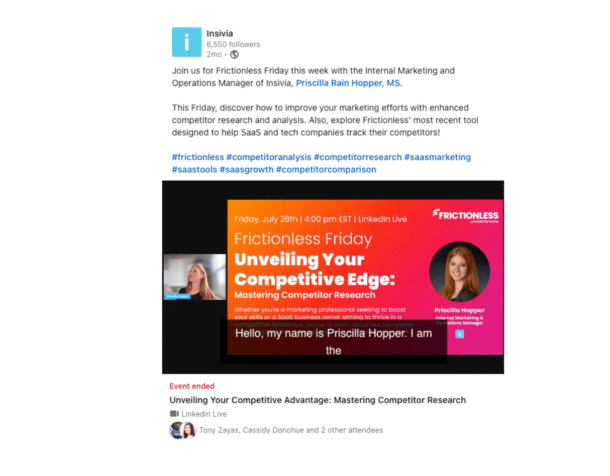In the dynamic realm of professional networking, LinkedIn stands as a distinct and evolving entity. Once a straightforward digital Rolodex, LinkedIn has transformed into an essential hub for professional content sharing and personal brand building. With nearly a billion users, the platform has entrenched itself as the cornerstone of professional online interaction and B2B marketing. However, to navigate this social network effectively requires a deep understanding of its core — the LinkedIn algorithm.
The significance of LinkedIn’s algorithm cannot be overstated. Unlike its social media counterparts, LinkedIn’s content dissemination framework is meticulously crafted to foster professional growth rather than viral entertainment. It is the silent gatekeeper, determining the visibility and reach of shared content, thus playing a pivotal role in any marketing strategy’s success or failure. Understanding and leveraging this algorithm is critical for those looking to harness the platform’s full potential.
This article delves into the strategic use of LinkedIn for B2B marketing, particularly through the lens of short, impactful micro videos. As the appetite for bite-sized content grows amongst professionals seeking quick insights and updates, micro videos have emerged as a powerful tool for awareness and authority building. By aligning with the platform’s latest algorithmic shifts heading into 2024, marketers can ensure their video content not only reaches but resonates with their intended audience. Herein, we’ll explore how to work with the nuances of the LinkedIn algorithm to elevate your B2B marketing strategy and establish a commanding digital presence.
Understanding LinkedIn’s Unique Algorithm
The Intent Behind LinkedIn’s Algorithm: Quality over Virality
LinkedIn’s algorithm is a carefully engineered system with a clear priority: quality over quantity, substance over sensation.
The core intent is to curate a feed that promotes professional growth, knowledge-sharing, and meaningful networking. Unlike platforms that thrive on the rapid-fire spread of content, LinkedIn adopts a more measured approach.
It’s designed to surface posts that contribute to users’ professional lives, whether through insights, news, or peer discussions.
In essence, LinkedIn’s algorithm is the platform’s commitment to maintaining a high standard of content that aligns with the professional nature of the network.
How the LinkedIn Algorithm Contrasts with Other Social Media Platforms
The LinkedIn algorithm sets itself apart from other social networks’ algorithms that amplify content with the highest engagement, often leading to virality.
Platforms like Twitter and Facebook have long optimized for content that generates quick, emotional reactions, prioritizing shares and likes that can propel a post to go viral. LinkedIn, on the other hand, gauges the professional value of content.
The algorithm looks beyond mere likes and shares, weighing in the relevance and utility of the content for the user’s career and professional interests. It’s a distinct approach that champions depth over the breadth of engagement.
The Rationale for LinkedIn’s Anti-Viral Stance
LinkedIn’s anti-viral stance stems from its foundational goal to be a productive and trustworthy space for professionals.
The platform understands that virality can often come at the cost of quality, and in the context of professional networking, this is a price too steep. The rationale is straightforward: what spreads fast is not necessarily what benefits the user professionally.
By discouraging virality, LinkedIn aims to ensure that its feed remains relevant, fostering an environment where valuable advice and expertise take the spotlight.
This thoughtful calibration helps users invest their time in content that offers professional enrichment rather than distraction.
The LinkedIn Algorithm: How It Works
Understanding how LinkedIn’s algorithm sorts and presents content can be the key to a successful B2B marketing strategy. Here is a closer look at the process:
Initial Content Classification: Spam or Valuable Content?
AI and Human Review Process
Upon posting, LinkedIn first classifies content through an AI system designed to filter out spam and policy violations.
This is a critical first defense in ensuring the quality of the feed.
However, AI isn’t infallible. It’s complemented by human oversight, where questionable content is subjected to review by LinkedIn’s team to decide whether it merits a place on the network’s feeds.
Examples of What Constitutes Spam on LinkedIn
Spam on LinkedIn typically includes:
- Engagement bait such as requests for likes, shares, and comments.
- Chain letters or content that encourages sharing for the sake of propagation rather than value.
- Overuse of irrelevant hashtags or repetitive posting.
- Posts crowded with excessive emojis or using reaction polls that do not contribute to professional discourse.
Engagement Testing Phase
The Role of Meaningful Engagement
Once a post is deemed valuable, LinkedIn tests it with a small audience to gauge engagement. Unlike other platforms where any engagement could boost a post’s visibility, LinkedIn’s algorithm looks for meaningful interactions.
Thoughtful comments and shares within relevant fields are valued more highly than simple likes or one-word responses.
The Downside of LinkedIn Pods in Distribution
LinkedIn pods — groups formed to mutually engage with members’ content — might seem like a clever way to game the system.
However, LinkedIn’s refined algorithm is likely to recognize and deprioritize inauthentic engagement patterns that don’t truly contribute to meaningful professional discourse.
Delivery of Valuable Content
Ranking Signals: Identity, Content, and Member Activity
Content that survives the initial scrutiny and engagement testing then circulates based on three key ranking signals:
- Identity: A user’s connections, interactions, and personal information, like job role and location.
- Content: The intrinsic value of the content, relevance to the audience, the professional nature of discussions it generates, and mentions of companies or topics.
- Member Activity: Engagement patterns such as groups joined, followed hashtags, and interactions with other posts.
Factors Influencing Content Visibility
Visibility is also influenced by factors such as:
- How recently the content was posted.
- The frequency of posts from the same author.
- The richness of the content in terms of media and descriptions.
- User feedback, such as reports of low quality or hiding a post.
By understanding these hierarchical steps of the LinkedIn algorithm, B2B marketers can craft their micro video content and overall strategy to align with the platform’s emphasis on fostering a professional and informative environment.
Recent Updates to the LinkedIn Algorithm
LinkedIn’s algorithm is not static; it evolves to align with the platform’s vision and its user’s needs.
The updates in June 2023 are a testament to LinkedIn’s ongoing commitment to enhancing user experience and content quality.
Overview of the June 2023 Algorithm Changes
The changes implemented in June 2023 represent a significant shift in how content is prioritized and disseminated across the platform.
LinkedIn’s algorithm has been tweaked to more effectively identify and promote content that is not just engaging but also enriching for the professional community.
Objectives of the Latest Updates
Encouraging Content That Shares Knowledge
A primary goal of the recent updates is to reward content that imparts knowledge, offers professional advice, or provides industry insights.
This pivot towards educational content indicates a push for thought leadership and expertise sharing, recognizing these as valuable currency within the LinkedIn ecosystem.
Enhancing the Connection Among Acquaintances
The latest algorithm changes are also geared toward reinforcing the fabric of professional relationships on LinkedIn.
The idea is to strengthen the network by surfacing more content from users’ first-degree connections and from within their broader industry sphere, fostering a sense of community and ongoing dialogue among professionals who are connected or share common interests.
Practical Implications for B2B Marketers
For B2B marketers, these updates necessitate a strategic realignment of content strategies. The implications are clear:
- Content Focus: There must be a shift toward creating and sharing content that educates, informs, and provides tangible value in terms of professional development or industry insights.
- Community Engagement: B2B marketing strategies should leverage the power of community by engaging more deeply with existing connections and focusing on growing a network organically.
- Authentic Interaction: Engaging in and fostering genuine conversations around shared content will be more beneficial than ever before. Marketers need to encourage meaningful dialogue to increase the reach and impact of their posts.
- Content Distribution: There’s a greater need for a targeted approach in content distribution. Marketers should identify and tap into niche groups and forums within LinkedIn that resonate with their brand’s expertise and value proposition.
The June 2023 updates to the LinkedIn algorithm serve as a call to action for B2B marketers to refine their strategies towards creating content that not only captures attention but also contributes constructively to their intended audience’s professional journey.
Videos In Social Media
In a digital age where attention spans are shrinking and visual communication is on the rise, video content offers unique advantages that make it an ideal choice for promoting SaaS and tech solutions.
Engagement and Accessibility: Video content is inherently engaging. It combines visual and auditory elements, making it more accessible and captivating than text or static images. SaaS and tech companies often deal with complex products and concepts, and video allows them to simplify and explain these ideas effectively, ensuring that potential customers understand the value proposition.
Demonstrating Product Functionality: Videos provide an excellent platform for demonstrating how a tech product or SaaS solution works. They can showcase the user interface, highlight key features, and walk viewers through real-life scenarios. This helps potential customers visualize the product’s utility and can lead to higher conversion rates.
Humanizing the Brand : Videos allow tech companies to humanize their brand. By featuring employees, sharing behind-the-scenes content, or even customer testimonials, companies can build trust and establish a more personal connection with their audience. People prefer doing business with companies they perceive as authentic and relatable.
SEO Benefits: Video content can improve a company’s search engine optimization (SEO) efforts. Popular platforms like YouTube are search engines themselves, and by optimizing video titles, descriptions, and tags, SaaS and tech companies can increase their visibility in search results. Additionally, search engines like Google often prioritize video content in their search rankings.
Social Media Algorithms: Many social media platforms, including Facebook, Instagram, and LinkedIn, favor video content in their algorithms. This means that video posts are more likely to appear in users’ feeds and gain organic reach. For SaaS and tech companies looking to expand their online presence, this preferential treatment can be a significant advantage.
Storytelling Opportunities: Video allows companies to tell compelling stories about their products or services. They can share customer success stories, discuss industry trends, or dive into the company’s journey and mission. Effective storytelling can create an emotional connection with the audience, making them more likely to remember the brand and engage with it.
Mobile-First Audience: As more people access social media on mobile devices, short, engaging video content is ideal for capturing the attention of on-the-go users. SaaS and tech companies can tailor their video content to cater to this mobile-first audience, ensuring that their message reaches a wide range of potential customers.
Data and Analytics: Social media platforms provide valuable analytics tools that allow companies to track the performance of their video content. This data can inform future marketing strategies, helping companies refine their approach and produce more effective videos.
Challenges:
Decline in Intentional Social Media Posting
Insivia, like any company, has challenges in gaining and sustaining intentional social media posts and engagement. While we didn’t experience significant negative fluctuations in engagement, we discovered that a shift towards more human-centric, community-oriented content led to a noticeable boost in positive online community engagement.

Maintaining a consistent and engaging social media presence can be demanding for any company, especially in the competitive tech and marketing industry. Our struggle stemmed from the need to strike a balance between sharing valuable industry insights and connecting with its audience on a more personal level.
By recognizing the importance of human-centric and community-oriented posts, Insivia tapped into a fundamental aspect of social media success: building relationships. Such content not only showcases the company’s expertise but also demonstrates its genuine interest in fostering a community and engaging with its audience.
This shift likely resonated with followers who were seeking more authentic and relatable content. Positive community engagement is a testament to the power of connecting with the audience on a human level, nurturing relationships, and fostering a sense of belonging within the online community. It highlights the significance of understanding your audience’s preferences and tailoring content to meet their needs while maintaining the authenticity of your brand.

Strategy:
Live Events for Social Engagement

Real-Time Engagement: Livestreaming provides a unique opportunity for real-time engagement with your audience. SaaS and tech companies can answer questions, address concerns, and provide instant demonstrations of their products or solutions. This immediate interaction builds trust and credibility.
Demonstrating Product Functionality: Just like video content, livestreaming allows companies to demonstrate the functionality of their products or services. Viewers can see how the software works in real-time, which can be particularly effective for tech companies with complex offerings.
Educational Content: Livestream events can serve as educational platforms. SaaS companies can host webinars, tutorials, or workshops to educate their audience about industry trends, best practices, and the benefits of their software. This positions the company as an authority in its field.
Product Launches and Updates: Livestreaming is an excellent way to unveil new products or announce updates and improvements to existing ones. The live format generates excitement and allows for immediate feedback, which can be invaluable for product refinement.
Building a Community: Hosting regular livestream events can help SaaS and tech companies build a dedicated community of users and supporters. It creates a sense of belonging and fosters a strong connection between the company and its customers.
Accessibility: Livestream events are accessible to a global audience. Anyone with an internet connection can participate, which can significantly expand a company’s reach and customer base.
Shareability : Livestreams are often shared and discussed on social media platforms. This sharing can lead to increased visibility and reach as viewers share the content with their networks.
Cost-Effective Marketing: Livestreaming can be a cost-effective marketing strategy compared to traditional advertising. It requires minimal equipment, and social media platforms typically offer livestreaming features at no extra cost.
Authenticity: Livestreams are inherently authentic. They are unedited and unscripted, which can create a genuine connection with the audience. People appreciate authenticity and are more likely to trust a company that shares its processes and knowledge openly.
Competitive Advantage: Many SaaS and tech companies have embraced content marketing and social media, but not all have ventured into livestreaming. Hosting livestream events can give your company a competitive advantage and set you apart from competitors.
Outcome:
Engaging Online Community
Since implementing a strategy focused on more human-oriented and informative events, Insivia has experienced a remarkable upturn in LinkedIn engagement rates, achieving several notable milestones.
In terms of visitors, Insivia garnered an impressive 7,857 page views and attracted 3,557 unique visitors, demonstrating a growing interest in the company’s content. Furthermore, the company achieved 438 custom button clicks, indicative of a highly engaged audience actively seeking more information.

Insivia’s efforts also significantly expanded its LinkedIn follower base, with 1,591 new followers, including 7 sponsored new followers and an impressive 1,584 organic new followers. This surge in followers reflects the resonance of our content and its ability to draw in a wider, more interested audience.
Engagement metrics underscore the success of Insivia’s strategy. A total of 597 reactions, 39 comments, and 117 reposts demonstrate the community’s strong response to the company’s posts. Impressively, the content reached a substantial audience, with 27,748 organic impressions and 62,009 sponsored impressions.
The pinnacle of this engagement is exemplified by Insivia’s highest-performing post, a Frictionless Friday post, which achieved a click-through rate (CTR) of 4.23%, 254 total views, 4 reposts, and an impressive engagement rate of 15.19%. This data underscores the success of Insivia’s human-centric and informative content approach, highlighting its effectiveness in connecting with and captivating its LinkedIn audience.
